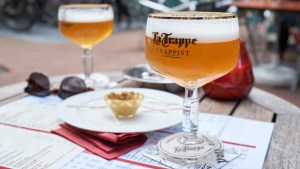Lenten Campaign 2025
This content is free of charge, as are all our articles.
Support us with a donation that is tax-deductible and enable us to continue to reach millions of readers.
During the Middle Ages, beer was considered a kind of liquid bread suitable for both monks and laymen, and part of the daily diet of both children and adults, alongside cabbage, onions, legumes, and bread. It was way cheaper and healthier than water and milk, which were often polluted and a means of transmission of many different infectious diseases. The brewing process eliminated all bacteria, making beer a safer alternative. Wine was too expensive to produce in northern European countries (that was obviously not the case in the Mediterranean) and tea, coffee, and chocolate had not yet been introduced in Europe.
However, that does not mean people did not drink water then. It is true that, as explained by Peter Konieczny, even if availability and quality of drinking water varied depending on various factors such as location, social class, and access to resources, water was still the most common beverage consumed by people of all social classes during the Middle Ages. It was readily available from various sources such as wells, springs, rivers, and rainwater. In urban areas, people often obtained water from communal wells located throughout the city. In rural areas, people relied on natural sources like streams and rivers instead.
Moreover, as Konieczny rightly puts it, “Medieval religious texts also mention drinking water. Some hagiographic accounts relate to how saints abstained from alcoholic beverages and drank water instead. Some of the more austere monastic communities also advocated relying on water.”

Again, drinking water was not always clean or safe to consume. Pollution and contamination were common issues, especially in densely populated areas. Many cities lacked proper sanitation systems, and waste often ended up in water sources. This contamination could lead to the spread of diseases such as dysentery, cholera, and typhoid. To mitigate these risks, people often boiled water before drinking it. Even if they might have had no understanding of bacteria, it was common knowledge that heat could make water safer to drink.
And still, the consumption of alcoholic beverages was widespread. Beer and ale were often preferred over water due to their lower risk of contamination. The fermentation process involved in making these drinks made them safer to consume than untreated water. Monasteries even produced light beers to feed children in monastic orphanages: They would be provided with a pint a day, mostly made from oatmeal or other heavy cereals, to feed them properly while keeping their room and board costs at a reasonable level. Also, it was observed that beer prevented and cured certain infantile illnesses, which we now know to be because of its antibiotic properties. For all these reasons, monasteries produced it regularly and abundantly.
In addition to water and alcoholic beverages, people also consumed other drinks such as herbal teas and infusions. These were often made from a variety of herbs, flowers, and spices, and were believed to have medicinal properties.
It is worth noting that the Middle Ages spanned a vast period and covered various regions, each with its own unique circumstances. Therefore, the drinking habits and practices regarding water consumption could differ significantly from one place to another, and from one century to the next. Making general statements about “the Middle Ages” often leads to misunderstandings, errors, and oversimplifications.



